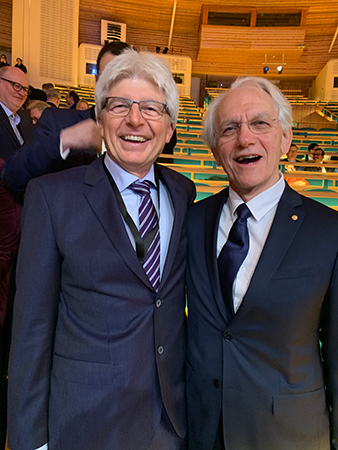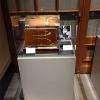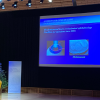 Dec. 20, 2018 - Samueli School professor Tibor Juhasz returned recently from this year’s Nobel Prize ceremony in Stockholm, Sweden, where he watched his longtime collaborator Gerard Mourou win one of the 2018 Nobel Prizes in physics.
Dec. 20, 2018 - Samueli School professor Tibor Juhasz returned recently from this year’s Nobel Prize ceremony in Stockholm, Sweden, where he watched his longtime collaborator Gerard Mourou win one of the 2018 Nobel Prizes in physics.
Because his own research is so closely intertwined with that of Mourou, Juhasz received an invitation to both the Nobel ceremony and the four days of events surrounding it, including lectures, discussions, receptions, parties and a banquet with the Swedish king and royal family.
Mourou is the A.D. Moore Distinguished University Professor Emeritus of Electrical Engineering and Computer Science at University of Michigan and a professor at Ecole Polytechnique in France. He and Juhasz began working together in January 1987, when Juhasz joined Mourou’s lab at University of Rochester as a postdoctoral researcher.
Two years earlier, Mourou and Donna Strickland (one of two others who shared this year’s physics Nobel) had written a paper about chirped pulse amplification (CPA) – the concept for which they ultimately won the Nobel. When Juhasz joined the lab, he worked on developing a novel particle accelerator using Mourou and Strickland’s CPA laser.
The CPA technique allows high-power femtosecond laser pulses to be generated without damaging the system’s amplifier. Years later, based on Mourou’s CPA concept, Juhasz developed the first ophthalmic femtosecond laser, spinning off a company called IntraLase Corp. The IntraLase device has been used in millions of corrective eye surgeries, including LASIK, and Mourou discussed it as part of his Nobel Prize lecture. In addition, Juhasz was asked to provide IntraLase’s first prototype as an exhibition piece for the Nobel Museum.
Juhasz first joined UC Irvine In the summer of 1987, when he finished his postdoctoral work with Mourou. He was hired by the physics department as a research scientist to investigate femtosecond laser applications in solid-state physics. He also served as a consultant to Mourou’s startup company, Medox Electro-Optics, which produced CPA laser parts.
While working with a Medox client, an ophthalmic firm in San Diego, Juhasz says he made a realization that would change his career focus. “I learned that the physics of laser-tissue interactions are similar to the physics of laser-matter interactions we studied at UCI,” he remembers. “This marked the beginning of my involvement in ophthalmology.”
Several years later, after talking with a colleague of Mourou’s at a conference, Juhasz received a telephone call from Mourou, who was then at University of Michigan. Mourou was interested in collaborating on the development of an ophthalmic femtosecond laser. In 1995, Juhasz joined his mentor on the faculty at Michigan, where he focused on laser-tissue interactions and designing a CPA laser system for ophthalmic applications.
At Michigan, Juhasz refined the CPA technology. His research team developed a solid-state diode-pumped system, eliminated the water-cooling requirement, shrank the laser to the size of a shoebox and increased its repetition rate substantially. These developments transformed the CPA laser into one that would be practical for ophthalmic surgery.
In 1997, Juhasz and University of Michigan ophthalmologist Dr. Ronald Kurtz launched IntraLase Corp. to commercialize femtosecond laser technology for ophthalmic applications.
The company, which started in Michigan and later moved to Irvine, went public in 2005; Advanced Medical Optics (AMO) acquired it in 2007. Later, it became the property of Johnson & Johnson Vision, which markets the same machine IntraLase designed 20 years ago for LASIK flap creation. To date, ophthalmologists have used the tool in more than 20 million surgeries.
In 2004, Juhasz rejoined UCI, as a professor with joint appointments in ophthalmology and biomedical engineering. He left IntraLase a few years after that.
His affiliation with Mourou has continued however; Mourou is on the board of Juhasz’s new startup company, ViaLase, a UCI spinoff that is developing new applications to treat anterior chamber disorders of the eye with the femtosecond laser.
Juhasz says he was ecstatic when he learned that Mourou was winning the Nobel Prize. “I stopped my car, jumped out, and I was jumping up and down for a while,” he says. “Gerard truly deserved this award, not only for his groundbreaking invention of CPA ... but also for his magnificent contribution to the optics community − from educating many excellent scientists to his visionary role in the establishment of numerous high-power laser research centers all around the word.”
He adds: “It is really a great feeling to be part of the Nobel Prize recognition, especially when it is related to helping millions of people by improving their vision.”
-Anna Lynn Spitzer


